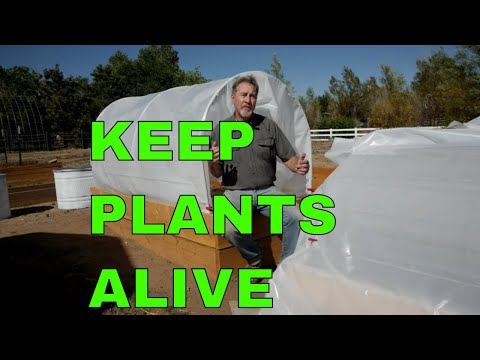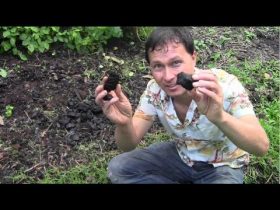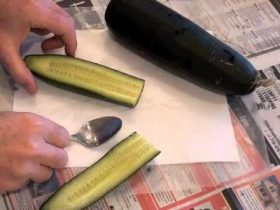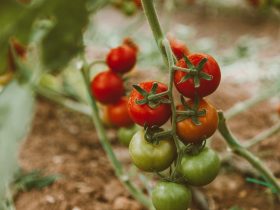Winter is coming. But that doesn’t mean that I want my plants to die any sooner than they need to. So join me as I show you how I keep my plants alive when cold weather threatens. And it is officially fall and this last week, in particular, I noticed that the nighttime temperatures are dropping below 50 degrees, that’s 10 degrees C.
And that can be a problem for some garden plants. For the warm season plants when it drops below 50 degrees, plants like tomatoes and peppers They’ll actually stop setting fruit and the whole plant begins to slow down a little bit. So to give the plants some more warmth at night, one answer is hoops covered with plastic.
There’s lots of other solutions for when the nighttime temperatures start getting cold and I’m going to show you a bunch of them right now. First let’s begin with the concept… why we’re putting plastic on our hoops. Well, it’s quite basic. During the day the sun is beating down and all those rays are warming the soil.
Well, typically, at night, all that warmth is released into the cold air. But in fall, in particular, if we can cover those plants with plastic, or many other materials. As that heat attempts to escape into the cold night air, it’s blocked by the hoops. The plastic is holding a lot of that warmth within the covered hoop and that helps keep the plants warmer.
The plastic I use is polyethylene sheeting and it comes in rolls of many different widths and lengths. I like the 12 feet wide. And the roll I got most recently is 100 feet long. It gives me a lot of plastic to be able to cut and cover a lot of beds. I do get the 6 mil thickness, not .6. Be careful because they sell that too.
It’s 6 mil, which is thick enough to hold up to wind and rain and snow and will be durable enough to last a few years. I’m going to cut this plastic to be seven feet long so I’ll make some marks at the seven feet and this is where I’ll make my cuts. And then just using a pair of shears I’ll cut right through the plastic along the marks I just made.
So with this plastic cut it’s ready to put over the hoop. Now remember it’s ten feet wide. So I’m going to be going in this direction. This is about eight feet long and I want some overlap on the side. So the eight feet plus the overlap will give me the 10. And I’ll just start unfolding this.
I cut it to seven feet because this was a six foot hoop. And so the seven feet will give me a little bit of overlap on both ends. So now I’ll just unfold this. And I’ll take a little spring clamp to hold it in position initially, just because it’s a windy day and I don’t want this blowing away.
And now I’ll just refine it, shift it a little bit, and get it into its final position. Using these spring clamps to attach the plastic directly to the hoop. And I want it to be as taut as possible. I got this collection of spring clamps I really like. It’s got small clamps that work real well for attaching the plastic to the smaller hoops.
And then it’s got these big spring clamps that work well to hold the plastic together when it bunches up. And I’ll put a link to these below. Because I can reuse this plastic. I’m going to mark on it what size it is, so that when I need it for another bed, it’s all ready to be picked off the shelf.
The ends of this bed are uncovered, but I’m okay with that because the plants inside are all cool season plants that can actually handle some frost. I’m just trying to gain a couple extra degrees of protection. Warm season plants can’t handle any frost at all. So you want to make sure the plastic cover over the hoops is big enough to fully enclose the ends as well.
So for my high hoops I’m going to go ahead and cut this 12 feet long, in addition to the 10-foot width. I’ve laid the plastic on these tall hoops with it 12 feet long from end to end. These hoops are ten feet long hoops, so the 10-foot width of this plastic will cover the hoops. The 12 feet allows me overlap on both ends.
And I’m using the big clamps to hold it in place as I spread it out and get it into position. If you have your hoops on the outside of your bed, or if you just want a more secure connection, I recommend taking a length of wood wrapping it along the edge, and then you staple the plastic to the wood.
And it hangs down and supports it pretty well. You can even screw these boards into your wooden bed. But my hoops are on the inside of the bed. So I’m actually going to use some of the tension from where the hoop contacts the bed to help hold it in position, and then I’ll use a spring clamp just to add a little bit of a more secure contact.
With the plastic in place Now I bring it all together and then using a big clamp at the top, I’ll put all the plastic together. And then I’ll use a small clamp at the bottom just to make sure that it’s completely covered. This low hoop bed is being covered by another sheet of plastic that’s ten feet wide and 12 feet long Because of the lower hoops, it completely encloses this bed.
So there’s very little chance of airflow getting in and cooling off the bed. And I’ll use the same clamps to keep it completely covered. The primary reason that I’m using a 10 foot by 12 foot sheet on this bed is because I like to reuse the sheets. This is also 10 by 12, so next year these sheets are interchangeable.
I can use both of them for high hoops, both of them for low hoops, or any combination, I don’t necessarily like to cut the sheets to size because I like that interchangeability, but there is also a factor about the plants that are growing inside this bed. If these plants are particularly sensitive to cold weather, well, this is completely enclosed.
The heat is being held in and there’s very little of that escaping. In this bed, well, the base does have some gaps so there is a little more loss of the warmth. So more tender plants have extra plastic. Less tender plants… it’s not as important. When it comes time to care for the plants, and to water, you have a couple options.
One is to roll up the sides of the plastic and that gives you access to the bed. You can also undo the clamps and now get access through the end. So how effective is it to cover the plants with plastic? Well Colorado State University did some studies and they determined that just that simple layer of plastic was able to keep the air two to four degrees Fahrenheit warmer underneath the plastic than the air outside.
And in field studies, that difference was as much as six degrees Fahrenheit. So imagine the temperature is dropping down to freezing overnight and we have plastic on our hoops. Well, inside that space our plants are really at about 37 degrees. That’s three degrees C. Enough to keep them alive when everything outside the hoop is frozen, And if we add one more layer, if we just add a mylar space blanket on top.
.. well, their studies showed that the temperatures inside stayed above freezing, even when the temperature dropped all the way down to zero degrees Fahrenheit. And if you want to gain even more of an advantage well, then take some glass or plastic jugs fill them with water and place inside the plastic covered hoop.
During the day the sun will not only warm the soil but it will warm that water and then at night all of that warmth is released underneath this hoop and the plants are really gonna be quite warm. So having those hoops and covering them with plastic is a great way to protect your garden when you know that cold weather is coming.
But what happens if you look at the nightly forecast and you realize it’s happening tonight? How can you quickly cover some of your plants if you don’t have hoops in place and you were really caught unprepared? If you want to keep individual plants a little warmer then make a cloche. This is just a plastic jug and I cut the bottom out of it.
It’s perfect size to just slip over a plant like these strawberries. Maybe I’ve got some fruit on them and I don’t want the fruit to freeze when a frost threatens. I do cut a little hole at the top of the handle, and then I’ll take some bamboo, or a long twig, and I’ll slide it through the handle into the soil so that it doesn’t blow away.
And now essentially I’ve created a little mini greenhouse around this individual plant. I’m guessing, as a gardener, you have some empty nursery pots lying around and these are ideal for protecting plants at the last minute. If you know it’s going to get cold tonight, pull a couple of these out, turn them upside down over your plants, and you’ve got instant protection.
A cloche will let some light through so they can be left in place the next day. These you will need to remove. And they’re not as easy to anchor so they might blow away, anyway. So take these off, look for the forecast, and decide if you need to use them again. They’re great for individual plants.
If you want to protect a large group of plants, I’ve got another idea. I like to use a tarp. This is just the tarp that I normally carry in my car. Just unfold it, spread it out, weigh down the ends with rocks or brick, and you’ve just covered all these plants and given them the protection that they’ll need overnight.
You can do the same thing with an old blanket. And you can even use the same plastic that you would have used in your garden to cover some tender plants that you don’t want to freeze. This is a pretty heavy material, so it’ll actually give a couple degrees of extra protection when temperatures drop near freezing.
It’s intended to be an overnight thing to do. Be sure to lift it off of the plants once the sun comes up the next morning and your plants will be just fine. That point is important to remember about taking it off during the day. We’re doing this to gain a few extra degrees at night. If we leave the plastic completely in place during the day, well, the heat will build up and build up and build up and not be released and we really could do some damage to our plants.
So roll up the plastic or loosen the ends so that there’s some airflow. Some of that heat can escape during the day and your plants will be much better. When it gets much colder, and we’ve got ice and snow, then yes, we can keep everything covered. But during this time of year we’re only looking for a couple degrees at night so let the plants breathe during the day.











Leave a Reply